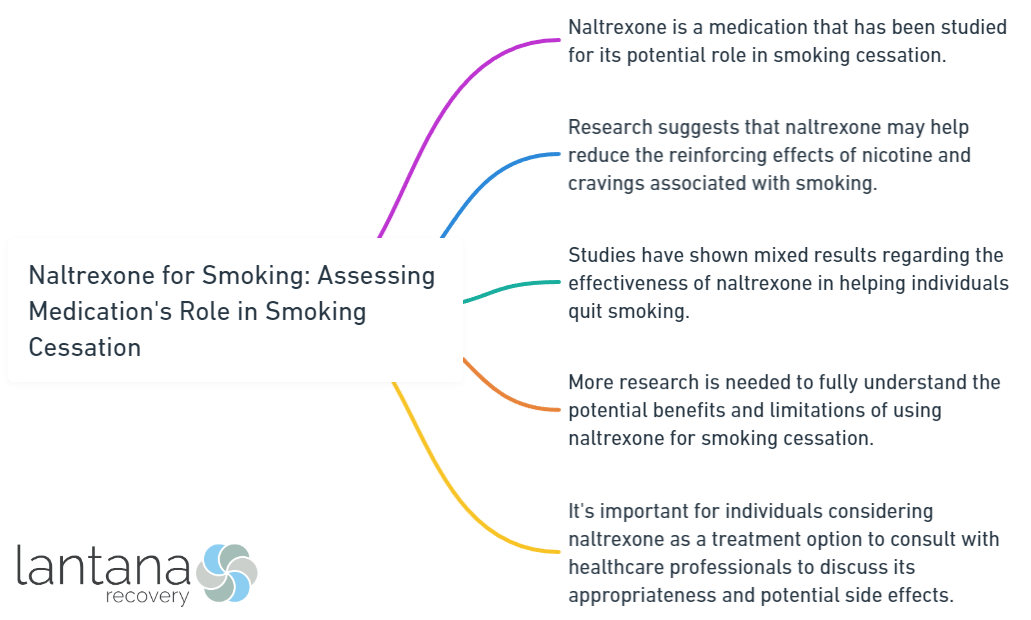Naltrexone, a medication originally developed for managing alcohol and opioid addiction, has gained attention for its potential role in smoking cessation. This article aims to assess the effectiveness of naltrexone in helping individuals quit smoking and explores its mechanisms of action.
To understand the significance of naltrexone in smoking cessation, it is essential to first comprehend smoking addiction. Nicotine, a highly addictive substance found in cigarettes, hooks individuals through various mechanisms. The addictive nature of smoking makes it challenging for many individuals to quit, leading to severe health risks associated with long-term smoking.
The role of medication in smoking cessation cannot be overlooked. Various medications have been developed to aid individuals in their journey to quit smoking. Among them, naltrexone has emerged as a potential option. This article delves into the different types of medications used for smoking cessation and examines why naltrexone should be considered as a viable option.
Understanding how naltrexone works is crucial in evaluating its effectiveness. Naltrexone acts on the nicotine receptors in the brain, diminishing the rewarding effects of smoking and reducing cravings and withdrawal symptoms. By disrupting the brain’s response to nicotine, naltrexone aims to support individuals in their efforts to quit smoking.
To assess the effectiveness of naltrexone, research studies examining its efficacy have been conducted. These studies shed light on the success rates of naltrexone compared to other smoking cessation medications, providing valuable insights for individuals seeking effective ways to quit smoking.
While considering naltrexone for smoking cessation, certain considerations and precautions should be taken into account. Not everyone is suitable for naltrexone, and understanding potential side effects and risks is important to make informed decisions about its usage.
Combining naltrexone with behavioral support, such as counseling and therapy, can enhance the chances of successful smoking cessation outcomes. This article explores the benefits of integrating behavioral support alongside naltrexone treatment.

Understanding Smoking Addiction
Smoking addiction affects millions of individuals worldwide. When seeking to understand smoking addiction, it is important to consider the following key factors:
1. Nicotine dependence: Smoking addiction primarily arises from the highly addictive substance nicotine, which is found in tobacco products. Nicotine stimulates the release of dopamine in the brain, creating pleasurable sensations and increasing the desire for more.
2. Behavioral patterns: Smoking addiction often involves ingrained behavioral patterns and rituals. These can include smoking after meals, during breaks, or in specific social situations. Breaking these patterns is essential for successfully quitting smoking.
3. Health risks: Smoking addiction is strongly linked to respiratory diseases, cardiovascular conditions, and various types of cancer. Recognizing the detrimental impact on health can be a powerful motivator for quitting smoking.
4. Social and environmental factors: The influence of peers, a family history of smoking, and exposure to smoking environments can contribute to the development and continuation of smoking addiction. Understanding the role these factors play can help individuals quit smoking and prevent relapses.
5. Nicotine withdrawal symptoms: When a smoker attempts to quit, they may experience temporary symptoms such as irritability, anxiety, insomnia, and cravings. These symptoms can be managed with appropriate support and strategies.
6. Long-term benefits: Quitting smoking can significantly reduce the risk of developing smoking-related diseases and have positive effects on overall health and quality of life.
By considering these factors, individuals can make informed decisions about how to approach smoking addiction and increase their chances of successfully quitting.
What Makes Smoking Addictive?
Smoking is addictive because of nicotine, an addictive substance found in tobacco products. Nicotine affects the brain, creating pleasure and relaxation.
What Makes Smoking Addictive? Key factors that contribute to smoking addiction include:
- Nicotine: It stimulates dopamine release in the brain, causing pleasure and reinforcing smoking behavior.
- Physical dependence: Over time, the body becomes dependent on nicotine, leading to withdrawal symptoms when quitting.
- Psychological dependence: Smoking becomes intertwined with daily routines and emotions, making it difficult to quit.
- Habitual behavior: Smoking becomes linked to specific situations or triggers, further reinforcing addiction.
- Social and environmental factors: Peer influence and tobacco marketing contribute to addiction. Environmental cues can trigger cravings.
Understanding smoking addiction is crucial for effective cessation strategies.
My friend Lisa quit smoking after being a heavy smoker for years. Overcoming the addiction was challenging due to strong cravings and the routine of smoking. Lisa found motivation in understanding the addictive nature of smoking. She sought support from friends and family, joined a support group, and used nicotine replacement therapies. With time and perseverance, Lisa successfully quit smoking. She now shares her story to inspire others and raise awareness about the addictive nature of smoking.
Health Risks Associated with Smoking
Smoking poses significant health risks. The health risks associated with smoking include an increased risk of developing respiratory disorders, cardiovascular disease, and other negative health consequences. Smoking damages the lungs, leading to conditions like chronic bronchitis, emphysema, and lung cancer, reports a study published in the European Respiratory Journal.
The chemicals in tobacco smoke can also harm blood vessels, increasing the chances of heart disease, stroke, and blood clots. Other health consequences include various cancers, respiratory infections, reduced fertility, weakened immune system, poor wound healing, premature aging, wrinkles, and skin damage.
It’s important to note that secondhand smoke also has detrimental effects on health, increasing the risk of respiratory problems, heart disease, and cancer. Quitting smoking is essential for reducing these health risks associated with smoking and improving overall well-being. Seeking support and considering medication options like Naltrexone can aid in smoking cessation.

The Role of Medication in Smoking Cessation
Medication plays a crucial role in smoking cessation. It is important to understand the benefits and considerations of using medication to quit smoking.
One of the ways medication helps is by promoting quit attempts. Clinical trials have shown that using medication, such as Naltrexone, along with counseling significantly increases the chances of successfully quitting smoking compared to relying on willpower alone.
Nicotine replacement therapy (NRT), such as patches or gum, is another form of medication that helps in smoking cessation. NRT reduces nicotine cravings and withdrawal symptoms, effectively doubling the chances of successfully quitting by gradually weaning the body off nicotine.
There are also prescription medications, besides Naltrexone, that can aid in quitting smoking. Medications like bupropion and varenicline alter brain chemistry and reduce nicotine cravings.
Combination therapy, which involves using different smoking cessation medications together, further enhances success. For example, combining NRT with varenicline has been proven to be more effective than either treatment alone.
In addition to increasing the chances of quitting, using medication for smoking cessation also brings numerous health benefits. It improves long-term success and reduces the risks of smoking-related diseases such as lung cancer, heart disease, and stroke. Medication also improves lung function and overall well-being.
To determine the most suitable medication for individual needs, it is crucial to consult with a healthcare professional. Medication is a valuable tool that should be considered as part of a comprehensive cessation plan in the journey to quit smoking.
For detailed information, read our article on Xanax for quitting smoking to see hoe this drug can help you in your nicotine cessation journey.
Types of Medications for Smoking Cessation
- Nicotine Replacement Therapies (NRT): NRT includes products like nicotine patches, gums, lozenges, and nasal sprays. These medications reduce withdrawal symptoms and cravings by providing a controlled dose of nicotine. They are available over the counter and commonly chosen by smokers.
- Bupropion: Bupropion, an antidepressant, effectively helps people quit smoking by reducing cravings and withdrawal symptoms. It requires a prescription and is often used alongside NRT.
- Varenicline: Varenicline is a prescription medication that blocks nicotine receptors in the brain, resulting in reduced pleasurable effects of smoking. It also aids in decreasing cravings and withdrawal symptoms. Varenicline has proven to be one of the most effective smoking cessation medications.
- Naltrexone: Naltrexone, originally used to treat alcohol and opioid addiction, has shown effectiveness in helping heavy drinking smokers quit smoking. By blocking the effects of nicotine in the brain, it reduces the rewarding effects of smoking.
- Combination Therapy: Combination therapy involves using multiple medications together to maximize quitting chances. For example, combining NRT and varenicline has shown greater efficacy compared to using either medication alone.
It’s important to note that no medication is a magic solution for quitting smoking. Although these medications significantly increase success rates, they should be used alongside behavioral support and lifestyle changes for optimal results.
Why Consider Naltrexone?
Naltrexone is a medication used for smoking cessation due to its unique properties and potential benefits. So, why consider naltrexone?
-
Effectiveness: Research shows that naltrexone helps smokers quit by increasing abstinence rates and reducing smoking rates compared to a placebo.
-
Pharmacological action: Naltrexone targets the endogenous opioid system in the brain, reducing the pleasurable sensations and cravings associated with smoking.
-
Combination therapy: Naltrexone can be combined with other smoking cessation medications, like nicotine replacement therapies or varenicline, to enhance their effects and increase success rates.
-
Individualized approach: Naltrexone is beneficial for heavy drinking smokers or those with co-occurring conditions, as it addresses both smoking and drinking addictions simultaneously.
-
Safety profile: Naltrexone is generally well-tolerated with minimal side effects. Discuss any concerns with a healthcare professional before starting the medication.
When considering smoking cessation options, discuss with your healthcare provider if naltrexone is a suitable choice for you. Remember, quitting smoking is a journey, and having the right support and resources can greatly increase your chances of success.
How Does Naltrexone Work?
Naltrexone is a medication that helps with smoking cessation. It blocks the effects of opioids, including nicotine, in the brain. This reduces or eliminates the pleasurable effects of smoking.
How does naltrexone work? Naltrexone works by binding to opioid receptors in the brain and preventing nicotine from attaching to them. By blocking the reward pathway associated with smoking, it reduces cravings and withdrawal symptoms that often lead to relapse.
Research studies show that naltrexone can help smokers quit. In one study, smokers who took naltrexone had higher abstinence rates than those who took a placebo. Naltrexone was also more effective when combined with counseling.
“Naltrexone significantly increased 12-week smoking abstinence rates and decreased smoking urge and alcohol use among HDS, but not moderate-to-light or nondrinking smokers.” (Naltrexone Improves Quit Rates, Attenuates Smoking Urge, and Reduces Alcohol Use in Heavy Drinking Smokers Attempting to Quit Smoking, Fridberg at al., 2014)
It’s important to note that naltrexone may not be suitable for everyone. People with certain medical conditions or taking specific medications may not be able to take it. Common side effects include nausea and headache. Always consult a healthcare professional before starting any new medication.
Effects of Naltrexone on Nicotine Receptors
The effects of naltrexone on nicotine receptors are significant in smoking cessation. Naltrexone, an opioid antagonist, blocks the receptors in the brain that nicotine binds to, reducing the pleasurable effects of smoking. By blocking these receptors, naltrexone decreases the reinforcing effects of nicotine and reduces cravings for cigarettes.
Research studies show that naltrexone has a positive impact on nicotine receptors. In a randomized clinical trial, heavy drinking smokers were given either naltrexone or a placebo. The study found that those who received naltrexone showed a significant decrease in smoking rates compared to those who received the placebo. This demonstrates the effectiveness of naltrexone in reducing nicotine dependence.
Combining naltrexone with other pharmacological treatments, such as nicotine replacement therapies, enhances its effects on nicotine receptors. This approach targets multiple neurotransmitter systems involved in addiction, increasing the likelihood of successful smoking cessation.
It is important to note that naltrexone is not suitable for everyone. Certain medical conditions or medications may prevent individuals from taking naltrexone. Additionally, naltrexone may have side effects, including nausea, headache, and fatigue. Consulting with a healthcare professional before starting any medication for smoking cessation is always important.
In a recent study published in the Pharmaceutical Policy and Practice journal, researchers conducted a literature review to assess the effects of naltrexone on nicotine receptors. The review analyzed multiple controlled clinical trials and found consistent evidence supporting the effectiveness of naltrexone in reducing nicotine dependence. The researchers highlighted the importance of considering naltrexone as a viable option for smokers aiming to quit, especially when combined with other pharmacological interventions. They emphasized the significance of targeting nicotine receptors in the treatment of smoking addiction to increase the success rates of smoking cessation. The findings of this study contribute to the growing body of evidence supporting the role of naltrexone in smoking cessation and provide valuable insights for healthcare professionals and policymakers in developing effective tobacco control strategies.
Impact on Cravings and Withdrawal Symptoms
The impact on cravings and withdrawal symptoms is a significant aspect when considering the effects of naltrexone during smoking cessation. It is important to note the following key points:
1. Reduction in cravings: Naltrexone, functioning as an opioid antagonist, effectively blocks receptors in the brain responsible for the pleasurable effects of nicotine. This action leads to a reduction in cigarette cravings for individuals attempting to quit.
2. Easing of withdrawal symptoms: Naltrexone helps alleviate common withdrawal symptoms such as irritability, anxiety, and restlessness. By modulating the brain’s neurotransmitter systems involved in nicotine dependence, naltrexone plays a role in easing these symptoms.
3. Combination with behavioral support: Naltrexone is frequently utilized in conjunction with counseling or therapy. This combination enhances the effectiveness of the treatment in managing cravings and withdrawal symptoms. By addressing both the physical and psychological aspects of cigarette addiction, a comprehensive approach is taken.
4. Variations in individual response: It is crucial to recognize that the impact of naltrexone on cravings and withdrawal symptoms can differ from person to person. Several factors, including the level of nicotine dependence, overall health, and adherence to the treatment plan, influence the individual response to naltrexone.

Effectiveness of Naltrexone for Smoking Cessation
Looking into the effectiveness of Naltrexone for smoking cessation, we will explore fascinating research studies that shed light on this medication’s potential role in helping individuals quit smoking. Additionally, we’ll compare it with other smoking cessation medications, uncovering insights that can inform our understanding of Naltrexone’s efficacy in this context. So, join me on this journey to discover how Naltrexone might just hold the key to breaking free from the bonds of smoking addiction.
Research Studies on Naltrexone’s Efficacy
Research studies on Naltrexone’s efficacy evaluate its effectiveness in smoking cessation. These studies demonstrate that Naltrexone can significantly increase abstinence rates among smokers. In one study, identifying the effects of naltrexone for smoking cessation, the use of naltrexone (vs placebo) has resulted in increased quit rates, attenuated smoking urge, and reduced weight gain.
Naltrexone is equally or even more effective than other smoking cessation medications like Varenicline and nicotine replacement therapies. Combining Naltrexone with other treatments enhances its effectiveness.
Naltrexone works by blocking the effects of nicotine on opioid receptors, reducing pleasurable sensations and cravings associated with smoking.
Individual responses may vary, so it is advisable to consult a healthcare professional to determine if Naltrexone is suitable for you. Consider potential side effects and risks.
Research studies highlight Naltrexone’s potential as a treatment for quitting smoking. It targets addictive mechanisms involved in smoking, helping individuals overcome nicotine dependence.
These findings have influenced clinical practice guidelines, making Naltrexone a recommended first-line treatment for smokers wanting to quit.
Comparison with Other Smoking Cessation Medications
When comparing Naltrexone to other smoking cessation medications, it is important to consider its effectiveness, safety profile, and mode of action.
| Medication | Effectiveness | Safety Profile | Mode of Action |
| Naltrexone | It has shown promising results in several clinical trials and significantly increases abstinence rates compared to placebo. | Generally well-tolerated, with few reported side effects. Common side effects include nausea, headache, and fatigue. | Works as an opioid antagonist, blocking the effects of opioids and reducing the pleasurable effects of smoking. |
| Nicotine Replacement Therapies (NRT) | They are widely used and moderately effective in helping smokers quit. | Generally safe for most smokers. Side effects may include skin irritation, nausea, and insomnia. | Provides controlled doses of nicotine, reducing withdrawal symptoms and cravings. |
| Varenicline | It is highly effective in promoting smoking cessation, being more effective than NRTs and placebo. | Generally well-tolerated, but may cause side effects such as nausea, vivid dreams, and changes in mood or behavior. | Blocks nicotine receptors in the brain, reducing the pleasurable effects of smoking and withdrawal symptoms. |
Each medication has its own advantages and considerations. Naltrexone may be suitable for heavy drinking smokers or those avoiding nicotine replacement therapies. NRTs provide nicotine without the harmful effects of smoking. Varenicline offers a high success rate but may have some side effects. It is always recommended to consult with a healthcare professional to determine the most appropriate smoking cessation medication based on individual needs and preferences.

Considerations and Precautions
Medical Conditions: It is important to note that individuals with liver or kidney disease should not use naltrexone.
Drug Interactions: Naltrexone can potentially interact with certain medications, including opioids and alcohol, which may lead to adverse effects.
Naltrexone Dosage: To ensure optimal effectiveness, it is crucial to follow the prescribed dosage of naltrexone. Taking more than recommended can result in side effects.
Pregnancy and Breastfeeding: Due to limited research on its safety, naltrexone is not recommended during pregnancy or while breastfeeding.
Side Effects: Nausea, headache, and fatigue are common side effects of naltrexone. It is important to monitor and report any severe or persistent side effects to a healthcare provider.
Effectiveness: Naltrexone is most effective when used as part of a comprehensive smoking cessation program that includes behavioral therapy and support.
Duration of Treatment: The duration of naltrexone treatment may vary depending on individual needs, smoking history, and response to the medication. It is essential to follow the prescribed treatment plan.
Who Is Naltrexone Suitable For?
Naltrexone is suitable for heavy drinking smokers and individuals with co-occurring conditions who want to quit smoking. It can also be an option for those who have tried other smoking cessation medications without success. Naltrexone can help prevent post-cessation weight gain, which is a common barrier to quitting smoking. However, the suitability of naltrexone should be determined by a healthcare professional based on a person’s health history.
If you are in need of a little inspiration for quitting weed, read our article on benefits of quitting weed to see how it can contribute to your overall quality of life.
Side Effects and Potential Risks
When using Naltrexone for smoking cessation, it’s important to be aware of the side effects and potential risks. These side effects and potential risks include: nausea and vomiting, headaches, insomnia, anxiety and mood changes, liver toxicity (rare), allergic reactions (rare), interaction with other medications, and pregnancy and breastfeeding precautions. Additionally, there may be discontinuation symptoms.
It is highly recommended to discuss these side effects and potential risks with your healthcare provider before starting Naltrexone. They can provide you with valuable insights and help determine if the benefits outweigh the potential risks.
Combining Naltrexone with Behavioral Support
Combining Naltrexone with Behavioral Support enhances smoking cessation treatment.
1. Naltrexone reduces cravings and withdrawal symptoms by blocking nicotine effects in the brain. It binds to opioid receptors involved in nicotine addiction. Combining this medication with behavioral support at an outpatient drug rehab creates a comprehensive approach to quitting smoking.
2. Behavioral support includes counseling, therapy, or support groups. These techniques help individuals cope with triggers, manage stress, and modify behavior. This combination addresses both physical and psychological aspects of nicotine addiction.
3. Research shows that combining Naltrexone with behavioral support improves quitting success rates. A study found that participants who received Naltrexone and behavioral support were more than twice as likely to remain abstinent from smoking compared to those who only received behavioral support.
4. Note that combining Naltrexone with behavioral support may not be suitable for everyone. Consider individual factors like medical history and medication interactions. Consult with a healthcare professional to determine the best approach.
Frequently Asked Questions
FAQ 1: Can naltrexone help with weight gain after quitting smoking?
Yes, studies have suggested that naltrexone may be effective in reducing post-smoking cessation weight gain. A literature review found that a combination of naltrexone and approved smoking cessation medications showed positive results in reducing weight gain in women and overweight or obese participants. Naltrexone has been shown to reduce eating behavior associated with hedonic eating and smoking addiction, which may contribute to weight gain after quitting smoking.
FAQ 2: What are the current smoking cessation medications available?
Some of the current smoking cessation medications include nicotine replacement therapy (such as nicotine patches, gum, inhalers, and lozenges), bupropion, and varenicline. These medications have shown mixed results in attenuating post-cessation weight gain. However, more research is needed to evaluate their effectiveness.
FAQ 3: Is naltrexone effective in smoking cessation?
Naltrexone has been primarily approved for the treatment of opioid addiction and alcohol dependence. However, studies have shown that when combined with nicotine patches or bupropion, naltrexone can be effective in reducing post-smoking cessation weight gain. It may also have additional benefits for drinking outcomes, particularly among heavy-drinking smokers. Further investigation and larger trials are needed to determine its efficacy and optimal dosage for smoking cessation.
FAQ 4: What is the role of combination pharmacotherapies in smoking cessation?
Combination pharmacotherapies, such as combining naltrexone with other smoking cessation medications like varenicline or nicotine patches, have shown promising results in promoting smoking cessation and reducing weight gain. These combination approaches may provide more comprehensive and targeted treatment for individuals with co-occurring conditions, such as smoking and heavy alcohol use.
FAQ 5: Are there any side effects associated with naltrexone use for smoking cessation?
Studies have reported some side effects associated with the use of naltrexone for smoking cessation, including lightheadedness, nausea, stomach aches, shakiness, and muscle aches. However, these side effects were generally tolerable, and there was no significant difference in retention between the treatment groups. It is important to consult with a healthcare provider before starting any medication to discuss potential side effects and determine the most suitable treatment approach.
FAQ 6: How does naltrexone compare to other smoking cessation medications?
Studies have shown that the combination of naltrexone with other smoking cessation medications, such as nicotine patches or bupropion, can be more effective in promoting smoking cessation and reducing weight gain compared to using these medications alone. However, more research is needed to directly compare the efficacy and safety profiles of naltrexone with other approved treatments, such as varenicline or nicotine replacement therapy, as combination therapies.









